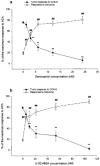Interactions between cholecystokinin and opioids in the isolated guinea-pig ileum
- PMID: 10433498
- PMCID: PMC1566095
- DOI: 10.1038/sj.bjp.0702621
Interactions between cholecystokinin and opioids in the isolated guinea-pig ileum
Abstract
1. Although cholecystokinin octapeptide sulphate (CCK-8) activates the opioid system of isolated guinea-pig ileum (GPI) whether it activates the mu- or kappa-system, or both, remains unclear. Neither is it known whether CCK-8 influences the withdrawal responses in GPI preparations briefly exposed to opioid agonists. This study was designed to clarify whether CCK-8 activates mu- or kappa-opioid systems or both; and to investigate its effect on the withdrawal contractures in GPI exposed to mu- or kappa-agonists and on the development of tolerance to the withdrawal response. 2. In GPI exposed to CCK-8, the selective kappa-antagonist nor-binaltorphimine elicited contractile responses that were concentration-related to CCK-8 whereas the selective mu-antagonist cyprodime did not. 3. In GPI preparations briefly exposed to the selective mu-agonist, dermorphin, or the selective kappa-agonist, U-50, 488H, and then challenged with naloxone, CCK-8 strongly enhanced the withdrawal contractures. 4. During repeated opioid agonist/CCK-8/opioid antagonist tests tolerance to opioid-induced withdrawal responses did not develop. 5. These results show that CCK-8 preferentially activates the GPI kappa-opioid system and antagonizes the mechanism(s) that control the expression of acute dependence in the GPI.
Figures







Similar articles
-
Inhibitory control of the acute mu-withdrawal response by indirectly activated adenosine A1 and kappa-opioid systems in the Guinea-pig ileum; reversal by cholecystokinin.Neurotoxicology. 2005 Oct;26(5):829-39. doi: 10.1016/j.neuro.2005.02.001. Neurotoxicology. 2005. PMID: 15894374
-
Mu and kappa opioid system interactions in the expression of acute opioid dependence in isolated guinea-pig ileum.Neuropharmacology. 1996 Mar;35(3):377-84. doi: 10.1016/0028-3908(95)00186-7. Neuropharmacology. 1996. PMID: 8783213
-
Withdrawal contractures of guinea-pig isolated ileum after acute activation of kappa-opioid receptors.Br J Pharmacol. 1993 May;109(1):48-52. doi: 10.1111/j.1476-5381.1993.tb13529.x. Br J Pharmacol. 1993. PMID: 8388301 Free PMC article.
-
Estrogen modulation of opioid and cholecystokinin systems in the limbic-hypothalamic circuit.Brain Res Bull. 1997;44(4):335-43. doi: 10.1016/s0361-9230(97)00212-8. Brain Res Bull. 1997. PMID: 9370197 Review.
-
Association of enkephalin catabolism inhibitors and CCK-B antagonists: a potential use in the management of pain and opioid addiction.Neurochem Res. 1996 Nov;21(11):1397-410. doi: 10.1007/BF02532381. Neurochem Res. 1996. PMID: 8947930 Review.
References
-
- BODEN P.R., HIGGINBOTTOM M., HILL D.R., HORWELL D.C., HUGHES J., REES D.C., ROBERTS E., SINGH L., SUMAN-CHAUMAN N., WOODRUFF G.N. Cholecystokinin dipeptoid antagonists: Design, synthesis and anxiolytic profile of novel CCK-A and CCK-B selective and ‘mixed' CCK-A/CCK-B antagonists. J. Med. Chem. 1993;36:552–565. - PubMed
-
- BORRIOS M., BAEYENS J.M. Differential effects of calcium channel blockers and stimulants on morphine-withdrawal in vitro. Eur. J. Pharmacol. 1988;152:175–178. - PubMed
-
- BRENT P.G., CHAHL L.A., CANTARELLA P.A., KAVANAGH C. The κ-opioid receptor agonist U-50, 488H induces acute physical dependence in guinea-pigs. Eur. J. Pharmacol. 1993;241:149–156. - PubMed
-
- CESSELIN F. Opioid and anti-opioid peptides. Fundam. Clin. Pharmacol. 1995;9:409–433. - PubMed
Publication types
MeSH terms
Substances
LinkOut - more resources
Full Text Sources
Research Materials

